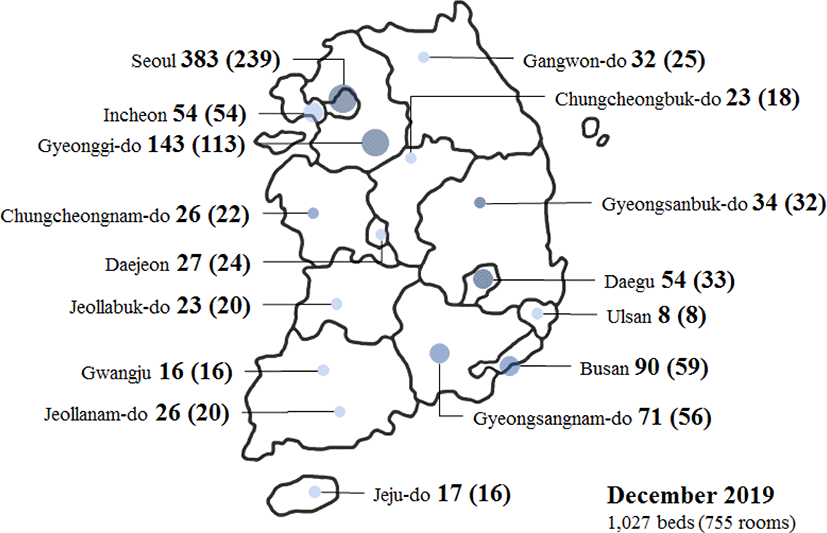Introduction
The novel coronavirus epidemic named COVID-19, which started in Wuhan, China, has spread to more than 190 countries, causing many infections and deaths, and this virus appears to be very contagious, making it difficult to effectively contain the virus. COVID-19 is thought to be transmitted from animals, although it has not been clear which animal is the main source (Ahmad et al., 2020). In general, COVID-19 is an acute resolved disease, but it can also be deadly, with about 2% case fatality rate, and severe disease onset might result in death due to massive alveolar damage and progressive respiratory failure (Xu et al., 2020). The incubation period of the COVID-19 is 1 to 14 days, and the mean is estimated to be 5.2 days, and 97.5% of those who develop symptoms will do so within 10.5 days of infection (Lauer et al., 2020). Current data show that the major transmission routes are droplets transmission, contact transmission, and aerosol transmission (Lu and Shi, 2020). There have been COVID-19 infections in many countries over the past few months, but we still do not know exact information about this virus. In addition, the COVID-19 outbreak in each country is quite different and the case fatality rate varies greatly from country to country. Nevertheless, what is becoming clearer is that mortality rates appear to be higher in the elderly, and the infection rate and mortality rate are lower in younger people. This is because symptomatic patients with the COVID-19 disease are the main disseminators, but asymptomatic patients should not be underestimated (Lu and Shi, 2020). Effective control of COVID-19 infection is thought to be very difficult. Therefore, the purpose of this study is to provide helpful information for other countries around the world control COVID-19 by experiencing COVID-19 infections in a relatively early period and presenting South Korea's experience of investing in total national capabilities into control of the virus infection. Moreover, the failures and successes Korea experienced will help other countries control the COVID-19.
History of COVID-19 infection in South Korea
On January 8, 2020, a suspected case of COVID-19 was identified for the first time in South Korea. The 36-year-old Chinese woman had a history of visiting the city of Wuhan from December 13 to 17 last year, and her case was reported to the Korea Centers for Disease Control and Prevention (KCDC, 2020) after being diagnosed with pneumonia during a visit to a hospital with related symptoms from the previous day. Three days later, on January 11, the KCDC concluded that the woman was not infected with the new coronavirus in Wuhan, China.
On January 20, a 35-year-old Chinese woman was confirmed to be the first case to be infected with the COVID-19 in South Korea (Fig. 1). The patient is a resident of Wuhan City, China, and she was diagnosed with a cold at a local hospital on Wednesday due to related symptoms. She was later quarantined and examined at Incheon International Airport in South Korea on Wednesday for showing symptoms of high fever and other symptoms, and she was transferred to Incheon Medical Center, a state-designated isolation hospital, after confirmation of the diagnosis. The KCDC said that the local infectious disease crisis alert level brought to light more suspected cases from the “interest” to the “attention” stage after the case was confirmed and began central headquarters and preventive measures against local government. Twenty-one cases were reported until Sunday, but all of them were declared negative and the quarantine was removed.
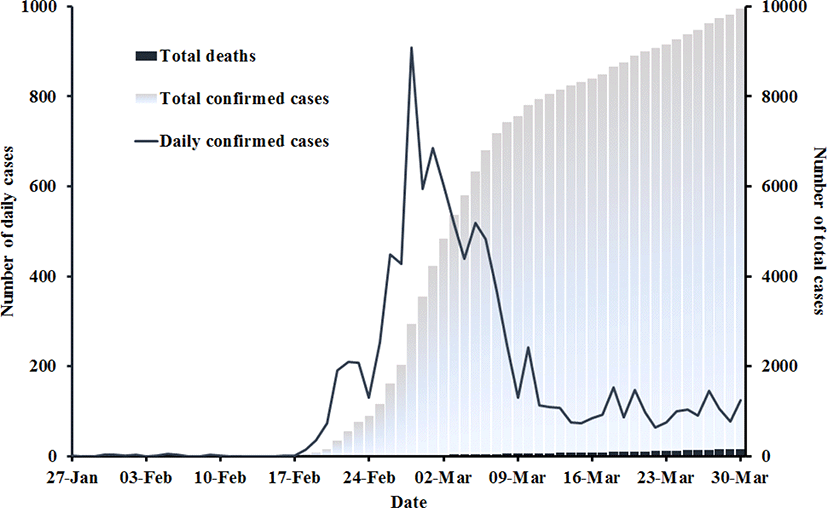
On January 23, South Korea's foreign ministry issued a “travel restraint” for Wuhan, China's Hubei Province, the second level of travel alert, and a “travel caution” for all of Hubei Province except for Wuhan. Moreover, the KCDC decided to send an epidemiological investigator to the Chinese diplomatic mission to protect Korean residents and investigate current happenings in regard to the COVID-19 on the same day. The Ministry of Public Administration and Security sent safety notices to the entire nation for the first time.
On January 24, the second case of COVID-19 in South Korea was confirmed. The patient, a 55-year-old Korean man who was working in Wuhan, China, visited a local medical institution with a sore throat that began on October 10 and was diagnosed with fever and sore throat during the quarantine process on his way home from Wuhan to Shanghai on Tuesday evening. The next day, a screening examination at the health center found him to be a confirmed case of COVID-19. The KCDC said that an in-depth epidemiological investigation found that a total of 69 people were in contact with the second patient and that active monitoring was conducted throughout the local health center regardless of whether symptoms were present or not.
On January 25, South Korea's Foreign Ministry raised its travel alert for the entire Hubei Province, including Wuhan, China, the origin of the COVID-19, to three levels (reconsider), recommending that people in Hubei leave the country unless it is urgent and requesting that trips of people who are scheduled to travel there be canceled or postponed. On the same day, the KCDC said that it will expand the contaminated area under surveillance at the airport's quarantine stage from Wuhan to all over China. This is based on the judgment that China's emergency blockade of the city of Wuhan has led to the closure of direct flights while the possibility of the virus coming from other regions has increased.
On January 26, the KCDC said that the third case of COVID-19 in South Korea was confirmed. The third patient was a 54-year-old Korean man who entered the country on May 20 after staying in Wuhan, China; he had no symptoms at the time of arrival, took a fever medicine on May 22, voluntarily reported having a cough with phlegm to the call center of the KCDC, and was quarantined at Myongji Hospital, a state-designated hospital for hospital treatment. The next day, the patient tested positive and turned out to be a confirmed case of COVID-19. In the process, the KCDC decided to reset the scope of active monitoring and quarantine standards after it was pointed out that the patient visited Wuhan, China, but he was not designated as a subject of active monitoring because he was not suffering from symptoms when he entered the country. Accordingly, the quarantine target was expanded and changed to “Anyone identified with fever or respiratory symptoms among visitors to China's Hubei province.”
Since the 31st case on February 17, a number of confirmed cases of COVID-19 occurred in Daegu and North Gyeongsang Province on February 19. Most of the cases occurred at church chapel (Daegu Church in Shincheonji) and were expected to continue to cause further confirmed case. The government immediately dispatched 18 response teams and six members of the Central Disaster and Safety Countermeasure Headquarters to Daegu City to control the situation along with cooperation from the city, and the government sent a “special government task force” to the area consisting of 28 related ministries, including the Ministry of the Interior and Safety, as the head of the Task Force team (director of the Ministry of Health and Welfare). With the arrival of 38 large-scale infections at a church in Daegu, Shincheonji, on February 20, the dormant COVID-19 outbreak has shifted to a new phase, raising fears of additional community infections.
On February 21, the fire department held an emergency video conference at the city's headquarter and issued fire department No. 1. Twenty-two ambulances and 44 paramedics were mobilized from the fire departments in Busan, Daejeon, Ulsan, North Chungcheong, Gangwon, and South Gyeongsang provinces.
On February 22, health authorities announced that the nation's second death was from pneumonia caused by the COVID-19. The 19-year-old man, who was confirmed to have COVID-19 in Busan on February 22, was the son of a Korean citizen who came from Wuhan and stayed at Asan Police Human Resources Development Institute.
On February 23, the number of confirmed cases of COVID-19 increased so rapidly in Daegu that it instantly reached 602, and the virus was mostly transmitted in the Daegu Church, Shincheonji. For this reason, private educational institutes were postponed and kindergarten, elementary, and middle schools were postponed too until March 9. Moreover, the crisis phase has also changed from “boundary” to “severity” (Fig. 2).
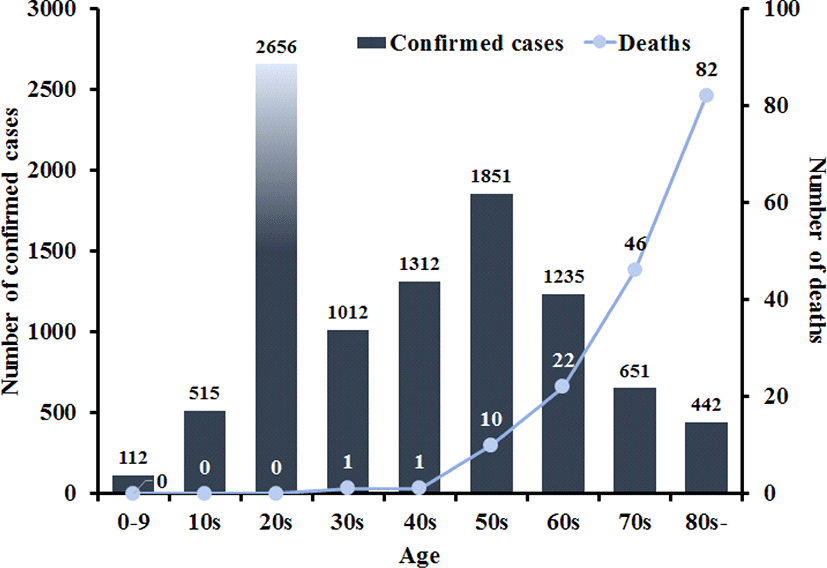
On February 24, there were an additional 161 confirmed cases of COVID-19, increasing the number to 833.
On February 25, the number of additional confirmed cases of COVID-19 increased to 977.
On February 26, the number of additional confirmed cases of COVID-19 increased to 1,261.
On February 27, the number of additional confirmed cases of COVID-19 increased by 505 to reach 1,766.
On February 28, the number of additional confirmed cases of COVID-19 increased by 571 to reach 2,337.
On February 29, the number of additional confirmed cases of COVID-19 increased by 813 to reach 3,150, and this was a very serious condition.
On March 1, there were an additional 586 confirmed cases of COVID-19, increasing the number to 3,736 infected people.
On March 2, the number of additional confirmed cases of COVID-19 increased by 599 to reach 4,335 causing a crisis. The start of the elementary, middle, and high schools was postponed until March 23.
On March 3, more people (+477; reach 4,812) were confirmed cases of COVID-19. The number of deaths increased by 2 to reach 28.
On March 4, there were 5,766 confirmed cases of COVID-19. The number of deaths increased by seven to reach 35 from the previous day. Since the first COVID-19 death on January 20, the first confirmed case of COVID-19 was reduced by 68 from March 12, as the church of Shincheonji, Daegu, was aggravated by the explosion of the church in two months, drawing “Golden Cross.” In other words, 177 people who were declared completely cured were removed from quarantine, and the number of new confirmed cases of COVID-19 was 110.
On March 14, the number of confirmed cases of COVID-19 was 8,086 and the number of deaths increased by five to reach 72.
On March 15, 8,162 confirmed cases of COVID-19 were reported, and the number of deaths increased by three to reach 75, and within two days of Golden Cross, the number of fully recovered patients surpassed that of the confirmed cases of COVID-19.
On March 16, 8,236 confirmed cases of COVID-19 were reported, and the number of deaths was 0. Special entry procedures for domestic and foreign nationals on all routes from Europe and the quarantine process were strictly enforced.
On March 17, 8,320 confirmed cases of COVID-19 were reported, and the number of deaths increased by 6 to reach 81. The government asked religious circles to practice social distancing and provided masks to vulnerable social groups.
On March 18, 8,413 confirmed cases of COVID-19 were reported, and the number of deaths increased by 3 to reach 84. The government recommended extending the closure of social welfare facilities.
On March 19, 8,565 confirmed cases of COVID-19 were reported, and the number of deaths increased by 7 to reach 91. Sampling tests were conducted for all nursing facilities in Daegu and Gyeongsangbuk-do.
On March 20, 8,652 confirmed cases of COVID-19 were reported, and the number of deaths increased by 3 to reach 94.
On March 21, 8,799 confirmed cases of COVID-19 were reported, and the number of deaths increased by 8 to reach 102. Recommendations for strong social distancing movement starting this day were made, 15 days before elementary, middle, and high schools started.
On March 22, 8,897 confirmed cases of COVID-19 were reported, and the number of deaths increased by 2 to reach 104.
On March 23, 8,961 confirmed cases of COVID-19 were reported, and the number of deaths increased by 7 to reach 111. In order to implement a strong social distancing movement, the government's regular briefings also switched to a non-face-to-face mode.
On March 24, 9,037 confirmed cases of COVID-19 were reported, and the number of deaths increased by 9 to reach 120.
On March 25, 9,137 confirmed cases of COVID-19 were reported, and the number of deaths increased by 6 to reach 126.
On March 26, 9,241 confirmed cases of COVID-19 were reported, and the number of deaths increased by 5 to reach 131.
On March 27, 9,332 confirmed cases of COVID-19 were reported, and the number of deaths increased by 8 to reach 139.
On March 28, 9,478 confirmed cases of COVID-19 were reported, and the number of deaths increased by 5 to reach 144.
On March 29, 9,583 confirmed cases of COVID-19 were reported, and the number of deaths increased by 8 to reach 152.
On March 30, 9,661 confirmed cases of COVID-19 were reported, and the number of deaths increased by 6 to reach 158.
On March 31, 9,786 confirmed cases of COVID-19 were reported, and the number of deaths increased by 4 to reach 162 (Fig. 3; Table 1).
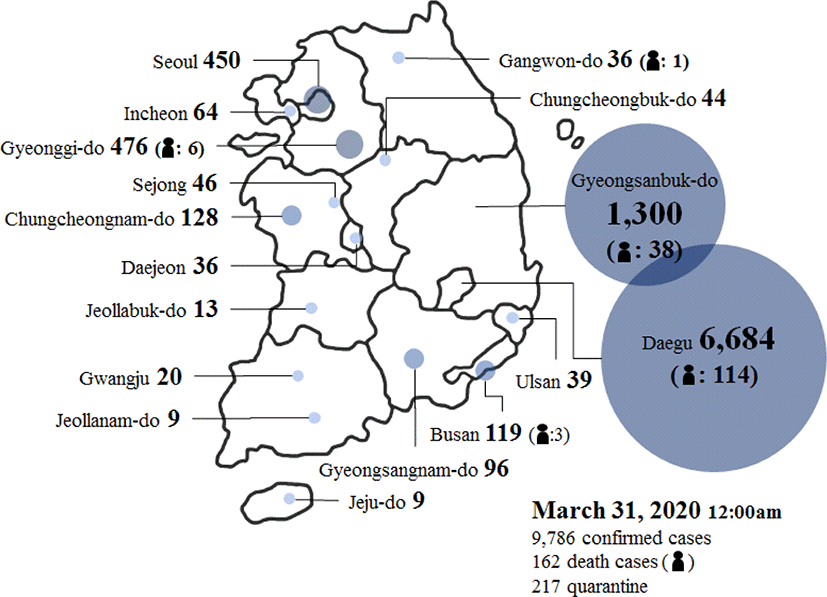
History of South Korea government's management of the COVID-19 crisis
-
- 2020. 01. 27 - Risk alert for infectious diseases→High alert.
-
- 2020. 01. 31 - Real-time gene amplification test.
-
- 2020. 02. 03 - Opening of a separate entry point for inbound travelers from China.
-
- 2020. 02. 04 - Foreign students to Hubei Province, China.
-
- 2020. 02. 05 - COVID-19 Disconnected Genetic Information Disclosure.
-
- 2020. 02. 09 - Support for living expenses and paid vacation expenses.
-
- 2020. 02. 12 - Preparing guidelines for group events.
-
- 2020. 02. 13 - Enhancing the prevention of inflow into South Korea (expanding special entry procedures and increasing follow-up management after entering the country through a self-diagnosis application that provides information on travel history to medical institutions/pharmaceuticals), imposing strengthening measures to ensure compliance with self-isolation by local governments, and checking operation plans by local governments.
-
- 2020. 02. 20 - Response to confirmed cases of COVID-19 in Daegu, North Gyeongsang Province, revision of COVID-19 response guidelines, and prevention and support of infections in medical institutions.
-
- 2020. 02. 21 - Response to confirmed cases of COVID-19 in Daegu, North Gyeongsang Province, quarantine and inspection of new members of Daegu Church in Shincheonji, high-risk group management and local quarantine measures, and preparation for increased demand for health masks in Daegu, North Gyeongsang Province.
-
- 2020. 02. 23 - Crisis Alert for Infectious Diseases Stage Boundaries→Advanced Seriousness, Introduction of the “National Safety Hospital” (a hospital that insulates serious respiratory diseases from light case or visitor during the entire course of care) and securing local beds and medical personnel.
-
- 2020. 02. 24 - Establishment of Central Disaster and Safety Countermeasures Headquarters and postponement of the start of the new semester of kindergarten, elementary school, middle school, and high school.
-
- 2020. 02. 25 - Securing and investigating the entire congregation list of Shincheonji Church.
-
- 2020. 02. 26 - Developing guidelines for group events, increasing quarantine management for multi-use facilities, revising guidelines for environmental sterilization, actively utilizing flexible work systems, restricting the export of masks to daycare centers nationwide, and making it mandatory for public sales outlets to be released.
-
- 2020. 02. 27 - Designation of a total of 127 National Safety Hospitals, support for life and economic compensation for dispatched personnel, support of military personnel, and recommendations for closing social welfare facilities.
-
- 2020. 02. 28 - Ensuring health and rest rights for medical personnel and rapid provision of protective equipment.
-
- 2020. 03. 01 - Confirmed cases of COVID-19 diagnosis classification according to severity of the disease; patients with mild symptoms are transferred to a “life care center” instead of inpatient care, and patients with secondary or higher levels are quickly hospitalized to infectious disease treatment hospital/national hospital admission beds.
-
- 2020. 03. 02 - Measures for blood donation (monitoring the health status of blood collecting workforce and encouraging participation in blood donation).
-
- 2020. 03. 03 - Reinforcement of social measures (National Behavioral Rules, Infection Control in Collective Facilities, and Special Management Area), Operation of Life Care Centers, and Emergency Care Services.
-
- 2020. 03. 04 - Distribution of standard operating guidelines for “Drive Thru” screening centers and expansion of beds for treatment of critical patients.
-
- 2020. 03. 05 - Extended vacation period for daycare centers (~3.22), recommended extension of closure of social welfare facilities (~3.22), adding special management areas for infectious diseases (Kyungsan, North Gyeongsang Province), and placement of public health care physicians (military doctors).
-
- 2020. 03. 06 - Expansion of negative pressure beds, establishment of information systems, and improvement of psychological support systems.
-
- 2020. 03. 08 - Promoting the use of the COVID-19 Active Administrative System (apply regulations and procedures as flexibly as possible in order not to miss the right time), and five-day rotation mask distribution system for purchase of public supply masks by the Ministry of Food and Drug Safety.
-
- 2020. 03. 10 - Postponing school opening (kindergarten, elementary, middle, and high schools), emergency care, on-site inspection of nursing hospitals, placement of military doctor personnel in local governments, and special entry procedures for people coming from Japan.
-
- 2020. 03. 11 - Intensive management of high-risk workplaces, establishment of patient management systems by city and province, and operation of critical emergency care centers.
-
- 2020. 03. 16 - The South Korean government and the National Assembly approved an 11.7 trillion Korean won extra budget (Fig. 4).
-
- 2020. 03. 20 - The South Korean government classified symptoms of COVID-19 infections into four stages (light, secondary, severe, and critical) to solve the shortage of hospital rooms.
-
- 2020. 03. 22 - All people entering Korea from Europe tested for COVID-19 infection and suspected and confirmed cases quarantined.
-
- 2020. 03. 27 - All people entering Korea from America tested for COVID-19 infection and suspected and confirmed cases quarantined.
-
- 2020. 04. 01- All people entering Korea from oversea countries tested for COVID-19 infection and suspected and confirmed cases quarantined.
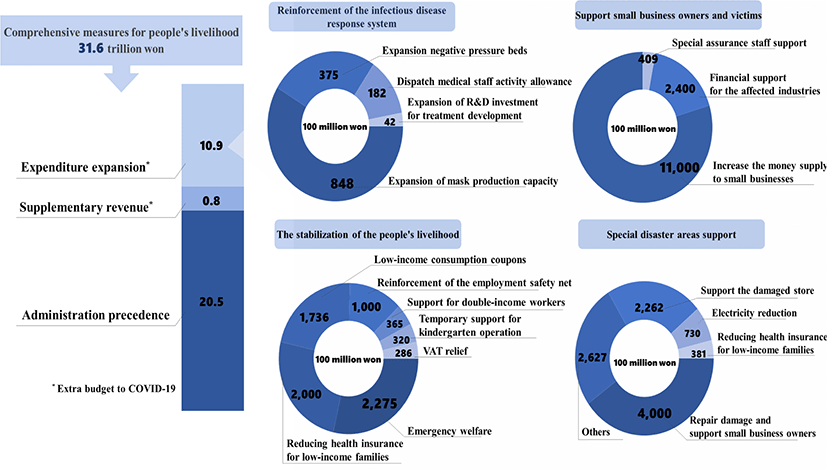
Procedure of COVID-19 test in South Korea
The South Korean government asked manufacturers of diagnostic kits to quickly develop a diagnostic kit in the early stages of the COVID-19 infection and promptly approved its use after it was completely developed (this procedure took one month). To improve the accuracy of the diagnostic kit and to upgrade its performance, diagnostic kits of several companies were cross-analyzed. The South Korean government tested all suspected people in order to quickly diagnose the virus and isolate the infected people. Summary of the virus diagnostic test and subsequent procedures is as follows (Fig. 5 and 6):
-
① People who need to test for viral infections enter select clinics
-
② Collecting nasal, mouth, saliva, and phlegm samples Everyone who has been tested should self-quarantine until the results of the examination are released
-
③ Diagnosis
-
④ If the diagnosis is negative, return to society and if positive, immediately enter a designated hospital
-
⑤ South Korea Central Disaster and Safety Countermeasures Headquarters immediately sends disaster text messages (age, gender, location of residence, etc., but not including name or address) to all local residents.
-
⑥ Started an epidemiological investigation such as symptoms of infection through conducting interviews, when the patient started showing symptoms, places they recently visited, where they moved, and who they met. In addition, secure mobile lines using cell phone GPS system, checking CCTV data, and credit card usage details, etc were used for epidemiological investigation.
-
⑦ Phone call someone who has come in close contact with an infected person to isolate him/her and undergo diagnostic test for the virus infection.
-
⑧ Sending the disaster text messages again including age, gender, location of residence, and route of movement of the infected person and personal hygiene practice, and more details are posted on the city's website.
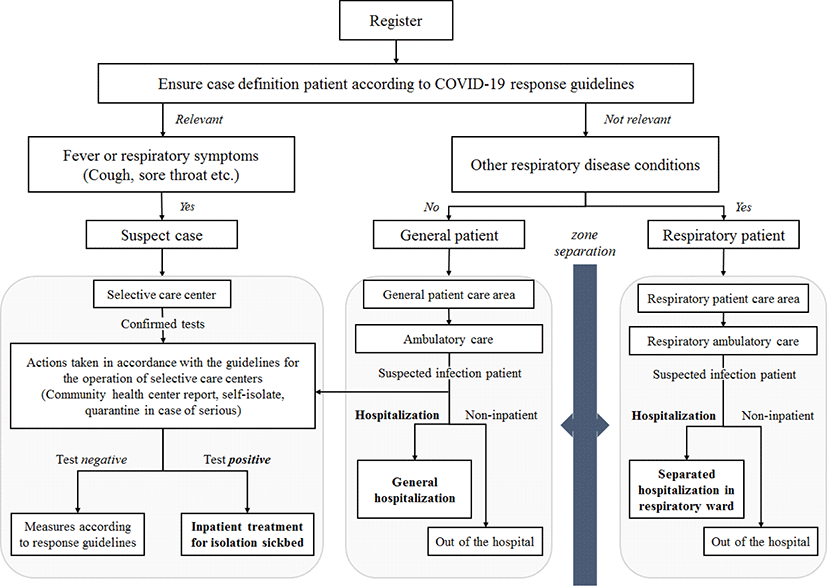
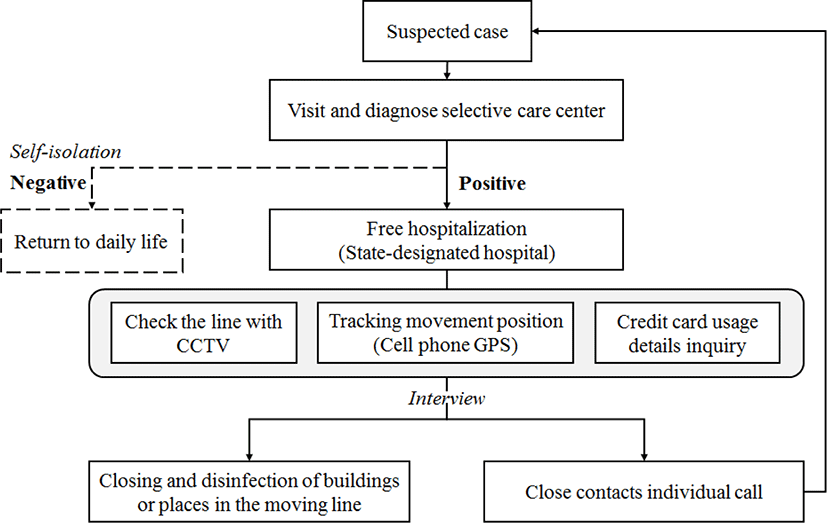
Status of negative pressure rooms in hospitals for COVID-19 in South Korea
The Ministry of Health and Welfare and the city government designated and operated a “Serious Emergency Care Center” that is responsible for treating patients with severe acute symptoms such as fever and respiratory symptoms. This aims to solve the problem of missing the right time (golden time) for treating patients with severe acute emergencies due to the failure of emergency room emergency patients who are worried about infection in emergency rooms due to the spread of COVID-19.
<Criteria for designation of a critical emergency care center>
-
* More than two (required) by city and province out of (targeted) advanced emergency rooms (recommended) and more than one (recommended) by 70 middle-age medical authorities
-
* Local emergency medical centers operated by advanced general hospitals and university hospitals
-
* (Required facilities) 1 isolation care area (5 beds or more) and a “pre-patient department” before entering the emergency room
-
* Modification and utilization of isolation (negative pressure, general) beds, caregivers' waiting room, emergency patient care area, and emergency rooms/external beds
-
* Isolation of one person within the isolation care area (transparent material bulkhead installation, opaque bulkhead installation under the CCTV surveillance)
The designated “Serious Emergency Care Center” classifies the severity and infection status in the “Pre-patient Classification Center” and provides first aid in the separate “Diagnostic Care Zone” for patients with severe acute symptoms, such as cough, fever, respiratory symptoms, etc. In addition, the “Serious Emergency Care Center” will restrict entry into emergency rooms for intensive care topatients with minorsymptoms.
The Ministry of Health and Welfare and the National Fire Agency prepared an appropriate hospital transport system based on the probability and severity of COVID-19 infection, and the medical institution provided support for patients with severe emergency medical conditions and suspected COVID-19 symptoms to receive appropriate emergency medical services quickly.
Mobile negative pressure systems used to convert general hospital rooms into negative pressure rooms purchased a total of 1,200 of mobile negative pressure systems sequentially by March 13 to support the necessary institutions, and negative pressure systems were supported in Daegu and North Gyeongsang Province after the date of the first confirmed diagnosis (Fig. 7; Table 2).
Inpatient treatment was not necessary, but patients who needed isolation for the purpose of blocking and monitoring virus infection were provided with living and medical support by setting up and operating “living care centers” in each region using national or accommodation facilities. The medical institution deployed a dedicated medical team to conduct frequent monitoring of the health status of the confirmed patients in the facility and promptly took them to the hospital if the medical team determined that hospital treatment was necessary. In addition, if the symptoms improved even while in the hospital, the medical institution take measures to treat the patient or to take care of him/her according to the judgment of the doctor in charge of treatment and the patient management team. The living care center was operated in the form of establishing a medical support system with nearby medical institutions by selecting facilities for each city and province and was operated from Daegu City first (Table 3).
With the cooperation of the Ministry of Education, the “Daegu 1 Living Treatment Center” started by utilizing the National Education Training Institute in Daegu City, and the “Daegu 1 Living Treatment Center” was operated by related agencies, including the Ministry of the Interior and Safety, the Ministry of National Defense, the Ministry of Health and Welfare, and Daegu City. A total of 17 medical personnel including medical staff from Kyungpook National University Hospital were assigned to the center, where 160 patients with minor symptoms could be admitted to the center, and they provided necessary medical services, including continuous and periodic management of medical symptoms. Patients who entered the hospital were transferred to another hospital or continued to live in a living care center after checking and diagnosing by the medical staff to see if there was a change in their health condition by performing self-monitoring twice a day, including measurement of body temperature and respiratory symptoms. In addition, supplies such as personal hygiene kits and personal relief kits (such as underwear, toiletries, masks, etc.) were provided to patients who entered the hospital, and meals and snacks were provided free of charge every day.
Disinfection before and after entering the hospital was carried out, and places where there was high frequency of contact with inmates, such as corridors and lifts, were disinfected every day to prevent the spread of infection; moreover, wastes generated were treated as medical wastes and managed safely. With the cooperation of Samsung, Gyeongsangbuk-do, and Yeongdeok-gun, the Samsung Human Resources Development Institute in Yeongdeok, North Gyeongsang Province, was also operated as a living care center for confirmed cases with minor symptoms, and the facilities were gradually expanded to prevent sudden deterioration of the patients' condition and to provide medical services safely. In addition, South Korea first introduced the national health insurance service system in 1963, and since 1989, all South Koreans were included in the National Health Insurance Service system and anyone can easily visit hospitals and get treatment at low cost. This national health insurance service system allows everyone to take diagnostic tests and treatments for COVID-19 for free.
Since March 2, 2020, the South Korean government classified symptoms of COVID-19 infections into four stages (light, secondary, severe, and critical) and treated patients with secondary, severe, and critical symptoms by hospitalizing them to negative pressure rooms or infectious disease pre-treatment hospitals, while patients with minor symptoms were treated in living care centers (government and private education centers, etc.) to solve the shortage of hospital rooms.
Drive Thru (and Walking Thru) system for COVID-19 in South Korea
The South Korea Central Disaster and Safety Countermeasures Headquarters prepared “A Standard Operating Model for Selective Care Centers” and a “Drive Thru” selective care center which enables large-scale sampling safely and efficiently. In screening treatment centers, people under inspection can perform door-to-door searches, heat checks, and sample collection through windows without getting off the car. Regular selective care centers take samples two times per hour and 20 times a day, while car mobility can save disinfection and ventilation time, allowing up to six cases per hour and 60 cases per day. In addition, test subjects do not get off the vehicle, which can lower cross-infection concerns among people waiting or the medical staff. The Central Disaster and Safety Countermeasures Headquarters plans to utilize the standard operating guidelines, including operation methods, staff composition, and space conditions and considerations, and distribute them to local governments nationwide.
In screening and sampling centers, the person to be examined does not get out of and high preferred for minimized transmission of infection and reduced disinfection and ventilation time (approximately 50 as of 3.3 days).
The scale of sampling of motor-portable models is shown below:
-
- Time required: 10 minutes or so for “receiving, medical, sampling, sterilization, education, etc.”
-
- Collection per hour: 6 cases (Drive Thru) vs. 2 cases (general screening center).
-
- One-day collection: 6 cases × 10 hours per day = 60 cases.
Key details of the standard operating guidelines are shown below:
-
① Receipt.
-
② Medical care (or a medical examination through interviews).
-
③ Sampling (upper and lower respiratory).
-
④ Disinfection and car point training.
This four-step process can be operated in two stages depending on the situation of the agency. It can operate from 4 to 8 according to the type of operation, for example, one to three administrative personnel (receiving patients, education, facility management, vehicle control, etc.), one to two doctors (care), one to two nurses (sample taking), and 1 quarantine (sterilization).
-
- (Space condition) Using the minimum area for parking and vehicle movement, installing a container or open tent type
-
- (Consideration) One driver (protectives not allowed), and a pre-booking system is required to reduce waiting time
Walking Thru is a clinic run by Yangji Hospital for COVID-19 examination that was established on March 16, 2020. There are four booths in the form of public phone boxes equipped with negative pressure facilities, and when someone comes in to be examined, the medical team simply put their hands outside the booth to collect samples from the nostrils and mouth. This Walking Thru booth is 2 meters high and 2 square meters in area, and when people demanding the test enter the room, the medical team examines the symptoms via interphone and collects specimens from the nose and mouth with a cotton swab, and also from saliva or phlegm. After sampling, the booth is sterilized for 5 minutes and sampling starts again. This system not only reduces the chances of clinicians contacting patients, but also saves the time needed to wear and take off protective gear, which is usually available for about 10 people an hour. The South Korean government has set up about 40 working thru booths at Incheon International Airport to quickly test for infections of the COVID-19 virus among travelers arriving from abroad. This drastically reduced the time to one minute for sampling and one to two minutes for ventilation and disinfection. Since then, South Korea has been increasing the number of Walking Thru diagnostic booths.
Diagnosis of COVID-19 infection in South Korea
The Ministry of Food and Drug Safety (MFDS) reported that a total of 42 companies applied for emergency approval of 64 COVID-19 infections diagnosis reagents at the KCDC between January 28 and February 28, 2020. The MFDS and KCDC approved diagnosis kits in four stages:
-
① Review documents (by the MFDS).
-
② Clinical performance assessment by the KCDC.
-
③ Expert review by the Korean Society for Laboratory Medicine.
-
④ Approval by the KCDC and by MFDS.
Of the COVID-19 related applications, 19 were reviewed, and four were approved for emergency use. Six cases were judged unfit due to poor performance, one case could not be evaluated for clinical performance, and eight cases were withdrawn from the companies. Currently, the MFDS is reviewing 45 applications, and eight will undergo clinical performance evaluations. Eight cases complement the evaluation data, while 29 cases are being reviewed by the MFDS. Four products approved for emergency use (Kogenebiotech, Seegene, SolGent, and SD BIOSENSOR) are all produced by South Korean medical equipment manufacturers, and 11,571 kits (522,770 people) were produced as of Tuesday, and 14,78 kits (38,500 people) were supplied and 4,493 kits were in stock.
History of public mask supply system for COVID-19 in South Korea
Due to the lack of masks, the South Korean government has been actively involved in supplying and selling masks since February 27, and 24,000 pharmacies nationwide have begun selling more than 2.4 million masks a day (Table 4). In post offices and Nonghyup (the National Agricultural Cooperative Federation), more than 1.1 million masks were sold daily. In particular, the medical institution in Daegu and the Daegu Medical Association provided 500,000 or more masks per day to vulnerable social groups. Despite the government's ban on the export of masks to foreign countries and measures to increase the production of masks, the supply was not sufficient. On March 11, 2020, the Post Office began selling the public mask.
Status of disaster text messages system for COVID-19 in South Korea
Emergency text messages were sent to mobile phones via mobile carriers for prompt evacuation in the event of a disaster. South Korea's National Fire Agency (Ministry of the Interior and Safety) decides whether messages will be sent or not and sends them after determining the transmission area (Fig. 8). Messages are sent to cell phones connected to base stations with Cell Broadcasting Service (CBS) systems. In fact, South Korea is very capable in building such a system because most adults and students have cell phones and have the most developed IT infrastructure. Therefore, it is possible to selectively set up custom alarms in disaster areas. Short messages, including disaster alerts and areas of occurrence, are sent as transmission content, and some include simple public action tips. There is no charge for the service as it is for the public interest to protect public safety. It was first introduced in 2003 and developed to date by solving various problems, and a disaster text message service through 5G network will soon be launched in South Korea. It does not require the process of collecting personal information, as it is used to send text messages to all “CBS-enabled” cell phones belonging to the local base station radius. Public institutions such as the Ministry of Health and Welfare, the Ministry of Environment, the Korea Meteorological Administration, and the Korea National Railroad are currently using them in situations that can affect public safety such as earthquakes, floods, heat waves, or other various disasters. Therefore, disaster text messages can be used to quickly know and respond to the presence of nearby COVID-19 confirmed cases in South Korea.
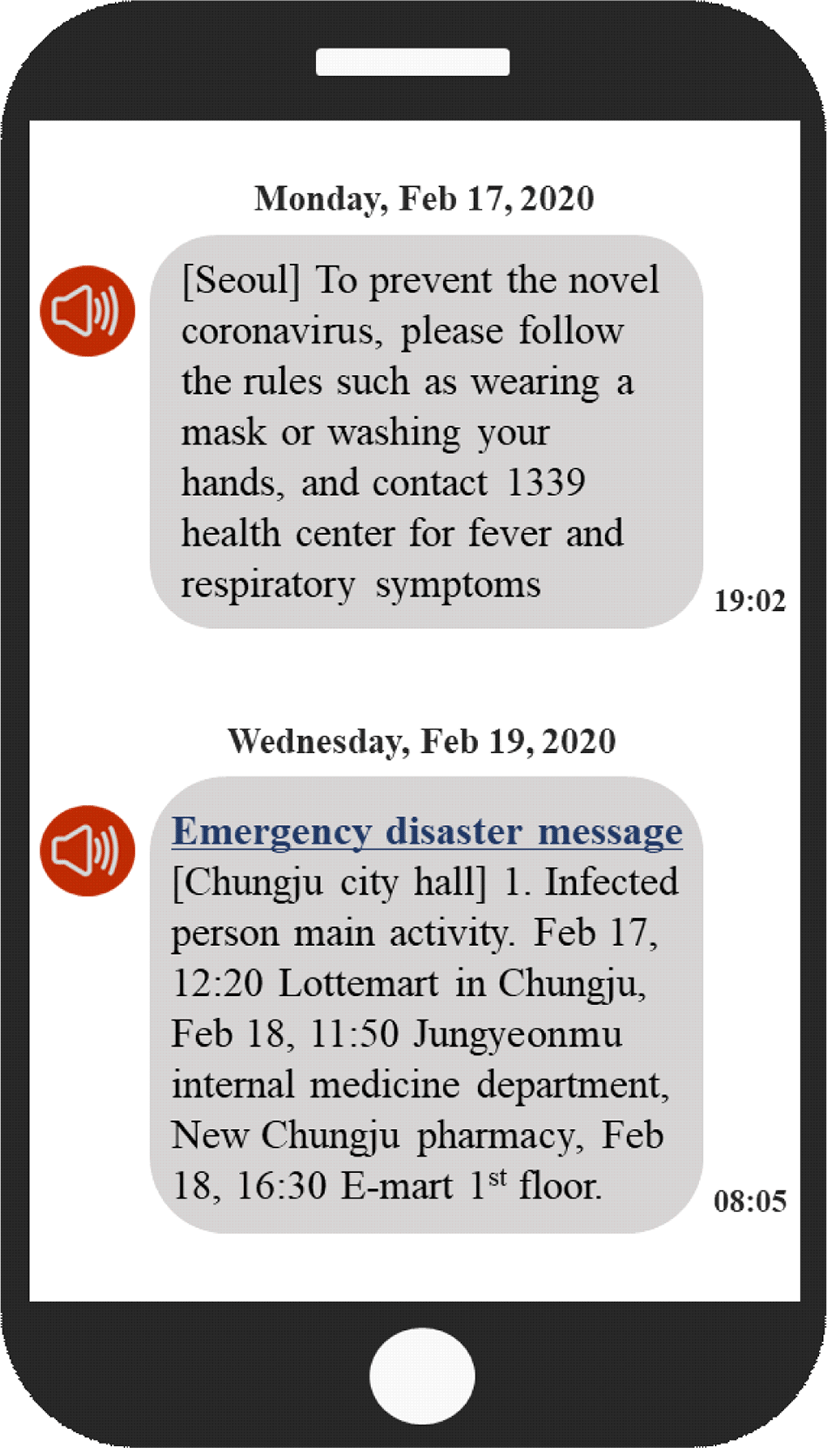
Status of special entry procedures in South Korea
Since March 22, 2020, the South Korean government began testing and isolating all people from Europe entering the country because of the increased number of cases of virus infections. In Korea, the government has adopted measures to prevent re-entry into Korea following the COVID-19 global pandemic. The government has decided to expand the scope of special entry procedures to all domestic and foreign visitors in Korea at midnight of March 19.
Application of special entry procedures enlargement
This measure was designed to strongly block the re-entry of risk factors into the country, considering the number of confirmed cases that occurred during the quarantine process and the propagation speed of the COVID-19 around worldwide. Accordingly, starting from March 22 midnight, all inbound visitors were required to fill out pre-distributed health questionnaires and special quarantine reports on the plane, measure body temperature, and, if necessary, receive a diagnostic examination, and quarantine inspections were imposed on the suspected cases. In addition, special quarantine inspections should be conducted, such as checking the address of stay in Korea, contact number (cell phone), and whether the self-diagnosis mobile phone app is installed.
All foreigners entering the country must report their health status (cough, sore throat, or fever, etc.) via the mobile phone app twice a day. In addition to the expansion of the special entry procedures, the government notified the local authorities of the list of all people entering the country to apply a more active monitoring system for 14 days after their arrival. The information of inbound people to countries with confirmed cases and countries with high probability of inflow into Korea is continuously provided to the medical institution (DUR/ITS) so that suspicious patients can be quickly identified and managed in the community. Everyone coming from Europe and entering the country gets a diagnostic test for the COVID-19 infection, and then the non-infectious person is required to report their health condition (cough or fever, etc.) to the government while they self-quarantine for 14 days, while those confirmed to be infected with the COVID-19 were taken to a hospital for treatment.
Role of soldiers and police to control COVID-19 in South Korea
Soldiers and police are also making great efforts to overcome COVID-19 in South Korea. The Army, Navy, Air Force, Marine Corps, and Special Forces actively donated blood to ensure smooth blood supply and demand. The army deployed a large number of troops to conduct extensive disinfection of virus-infected areas. The Air Force used military transport planes to transport 80,000 surgery gowns and medical equipment. The police are carrying out many tasks, including cracking down on mask cornering and on fake KF masks, as well as transporting patients and shutting down buildings. The South Korean government has also sent several special chartered flights to bring home Korean residents in Wuhan, China, and other areas of the world such as Japan, Vietnam, South America, and European countries. South Korean residents who arrived at Incheon International Airport in South Korea took COVID-19 virus tests before and after being quarantined for 14 days at a government-designated residential facility on a police bus. Korean residents paid for the ticket for the chartered flight, and all costs of the 14-day quarantine and the COVID-19 tests were paid by the South Korean government.
Conclusion
As of April 1, 2020, the South Korean government has actively implemented several measures including quarantine, disinfection, isolation, treatment, and prevention strategies against the COVID-19 infection and responded to the crisis by transparent disclosure of all data related to the strategies against the virus to the whole world. The release of transparent information related to virus infection and its related measures are the most important strategies in controlling the COVID-19. At the same time, Korea has not completely blocked the entry of people from all over the world and tried to meet the needs of its people. There was much criticism for not completely blocking Chinese citizens from entering the country in the early stages of the COVID-19 outbreak, and not only experienced the worst situation of the virus spreading to the community by a religious group called Sinchonji, infection continued in various other religious groups or collective living facilities. Moreover, there were controversies over the fact that the disclosure of transparent information was an excessive violation of human rights. In this situation, the South Korean government's active efforts and the cooperation of the Korean people (manifested in social distancing, wearing masks, personal hygiene practice, and not panic buying, etc.) have helped control the spread of the COVID-19 virus. The measures taken by South Korea to control COVID-19 infections may not be the best way to go, and there is no guarantee of how the virus infection situation will proceed in the future. However, we believe that the way the South Korean government and Koreans controlled the virus shows a new mechanism that democratized countries can follow in the future.








